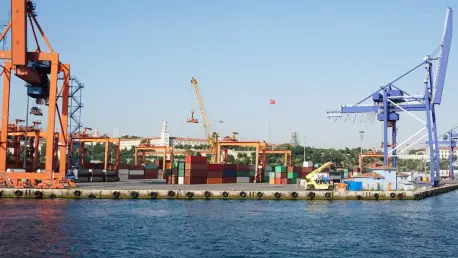Short introductionToday, we’re thrilled to speak with Rohit Laila, a seasoned veteran in the logistics industry with decades of experience spanning supply chain and delivery. His passion for technology and innovation has positioned him as a thought leader in transforming port operations and embracing sustainability. In this conversation, we dive into the evolving landscape of federal funding for ports, the implications of recent legislative changes like President Trump’s One Big Beautiful Bill Act, and the critical role of programs like the Diesel Emissions Reduction Act (DERA) in driving environmental progress at major U.S. ports.
Can you walk us through what President Trump’s One Big Beautiful Bill Act entails and how it’s reshaping funding for environmental initiatives at ports?
Absolutely. The One Big Beautiful Bill Act, signed into law in July, is a significant piece of legislation that alters funding for various programs, including those tied to environmental efforts. Specifically, it modifies and rescinds portions of funding previously allocated under the Inflation Reduction Act. For ports, this means a potential reduction in resources for projects aimed at cutting greenhouse gas emissions. The law has led to the rescission of unobligated funds, including $60 million that was meant for the EPA to support grants, rebates, and loans for diesel emission reduction. This kind of cut can create uncertainty for ports planning long-term sustainability projects, as they may need to rethink budgets or seek alternative funding sources.
How are ports adapting to these changes in federal funding landscapes introduced by the new law?
Most ports, so far, seem to be managing without immediate disruption. Many have previously awarded grants or can tap into other funding streams, which provides a buffer. For instance, some ports have existing DERA grants with agreements already in place, so they’re not directly hit by the recent rescissions. However, there’s a lingering concern about the pace of new grant agreements, as reviews initiated by the Department of Transportation could slow things down. While the full impact isn’t felt yet, ports are definitely keeping a close eye on how this unfolds and preparing to pivot if needed.
Could you explain the significance of the Diesel Emissions Reduction Act (DERA) in the context of port operations?
The DERA program, launched in 2008, has been a game-changer for ports looking to curb diesel emissions. It provides grants that help fund the replacement or retrofitting of older, high-polluting equipment with cleaner alternatives. Think drayage trucks, electric yard tractors, gantry cranes, and even switch locomotives with battery-electric technology. Over the years, DERA has been instrumental in helping ports meet stricter air quality standards while modernizing their fleets. Without this funding, many ports would struggle to finance these upgrades, which are crucial for both environmental and operational goals.
For ports like Los Angeles and Long Beach, which have benefited from DERA grants in the past, how are they navigating the current funding environment?
Both the Port of Los Angeles and the Port of Long Beach have a history of leveraging DERA grants for impactful projects, like replacing diesel engines with electric alternatives or swapping out old yard tractors for electric models. Right now, they’re not directly affected by the new law since they don’t have active DERA projects facing funding cuts. For example, Los Angeles used a $2 million grant in 2021 for a battery-electric locomotive, and Long Beach funded electric yard tractors back in 2019. Their past awards are secure, but looking ahead, they’re likely evaluating other funding avenues to keep their sustainability efforts on track if federal support wanes.
The Port of Oakland has expressed disappointment over potential future cuts to DERA funding. What concerns are they raising, and how might this shape their plans?
The Port of Oakland is worried about the possible elimination of future DERA grant rounds, which they see as vital for investing in emerging technologies and infrastructure. They’ve previously used DERA funds for projects like retrofitting cargo handling equipment with diesel particulate filters and replacing heavy-duty trucks. Without this federal support, innovative projects—potentially involving electric or hybrid systems—could be delayed or scrapped. They’re actively working with congressional representatives to advocate for continued funding and are likely exploring state or private partnerships as a backup to keep their environmental goals moving forward.
The Northwest Seaport Alliance is currently utilizing DERA funds for a truck replacement project. Can you tell us more about this initiative and how they’re handling funding uncertainties?
Yes, the Northwest Seaport Alliance received a $900,000 DERA grant in 2023 to replace 30 older drayage trucks—those with pre-2007 engines—with newer, cleaner diesel models from 2017 or later. This is part of their broader Northwest Ports Clean Air Strategy, and they’ve already scrapped hundreds of trucks using DERA funds in recent years, often covering about 50% of the cost per truck. While the recent $60 million EPA funding cut doesn’t directly impact this project, they’ve acknowledged that a reduction or loss of DERA grants in the future could make it tough to launch similar initiatives. They’re bracing for that possibility by scouting other funding options to sustain their emission reduction efforts.
What is your forecast for the future of environmental sustainability programs at ports given these funding challenges?
I think the future of sustainability at ports will hinge on adaptability and collaboration. While federal funding like DERA has been a cornerstone, the uncertainty around programs due to legislative changes means ports will need to diversify their funding portfolios—leaning more on state grants, private investments, and public-private partnerships. I also expect to see a push for innovation in cost-effective technologies that reduce emissions without heavy reliance on grants. Ports are resilient, and with the growing emphasis on clean air and climate goals, I believe they’ll find ways to keep momentum, though it might be at a slower pace if federal support continues to shrink. The key will be strategic planning and advocacy to ensure environmental priorities don’t fall by the wayside.









